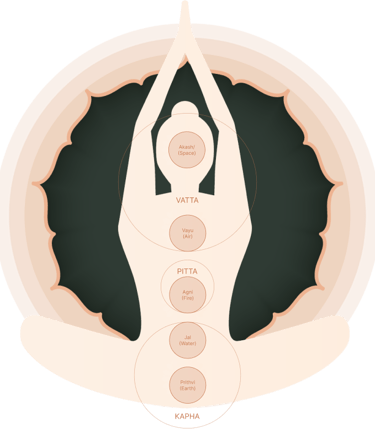Harmonizing Health
"The Interplay of Agni, Prakriti, and Vikriti in Ayurveda"


In Ayurveda, Agni, Prakriti, and Vikriti are interconnected concepts that play a fundamental role in understanding an individual's health and well-being:
Agni (Digestive Fire): Agni represents the digestive fire within the body. It is responsible for breaking down and assimilating the nutrients from the food we eat. Healthy Agni is crucial for proper digestion, absorption, and metabolism. It comes in various types, including Jatharagni (digestion in the stomach), Bhutagni (digestion in the tissues), and Dhatvagni (digestion in the cells). The strength and balance of Agni greatly influence a person's overall health.
Prakriti (Constitution): Prakriti refers to an individual's innate and natural physical and mental constitution. It is determined at the time of conception and remains relatively stable throughout a person's life. There are three primary constitutional types, or Doshas: Vata, Pitta, and Kapha. Prakriti defines a person's physical characteristics, mental tendencies, and vulnerabilities to certain health issues. Understanding one's Prakriti helps in tailoring a lifestyle, diet, and wellness practices that promote balance and prevent imbalances.
Vikriti (Imbalance): Vikriti refers to the current state of an individual's health, which may deviate from their natural Prakriti due to various factors such as diet, lifestyle, stress, environmental influences, and disease. Imbalances in the Doshas can lead to a wide range of health issues. Ayurvedic diagnosis and treatment involve assessing Vikriti to identify and address these imbalances. The goal is to bring a person's health back into harmony with their Prakriti.
The relationship between Agni, Prakriti, and Vikriti is as follows:
Agni and Prakriti: Each Prakriti type has its unique characteristics, including specific digestive tendencies. For example, individuals with a predominance of Pitta Dosha tend to have a strong digestive fire (Agni) and can typically handle spicy and hot foods better. Those with Vata Prakriti may have a more variable and sensitive Agni, requiring regular eating and warm, grounding foods. Kapha individuals may have a slower Agni and need lighter, more stimulating foods to maintain balance.
Agni and Vikriti: Imbalances in Agni can lead to Vikriti or health issues. For instance, a weakened Agni may result in poor digestion, leading to the accumulation of toxins (ama) in the body. An excessive or imbalanced Agni can also contribute to various health problems. Identifying Agni imbalances is crucial in Ayurvedic diagnosis, as correcting Agni is often a key aspect of treatment.
Prakriti and Vikriti: Imbalances that occur in Vikriti often manifest differently in individuals with different Prakriti types. For example, a Pitta individual experiencing an imbalance may show symptoms related to excess heat, such as acidity or skin rashes, while a Vata individual may exhibit symptoms like anxiety or irregular digestion. Ayurvedic treatment is tailored to address these imbalances while considering the individual's Prakriti.
In summary, Agni, Prakriti, and Vikriti are intimately linked in Ayurveda, and understanding their relationships is essential for maintaining health and well-being. The goal of Ayurvedic practices is to maintain a balanced Agni, align Vikriti with Prakriti, and promote overall harmony and vitality.

